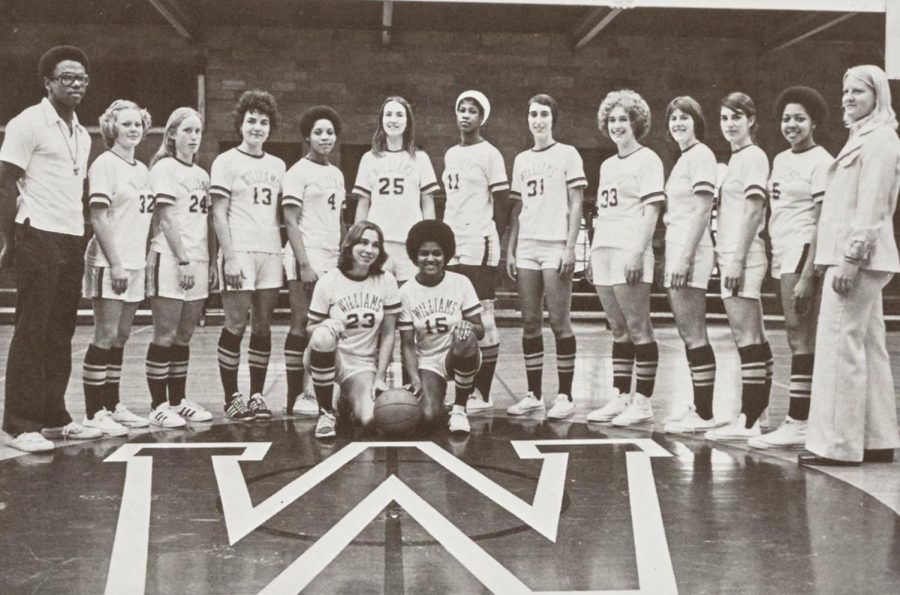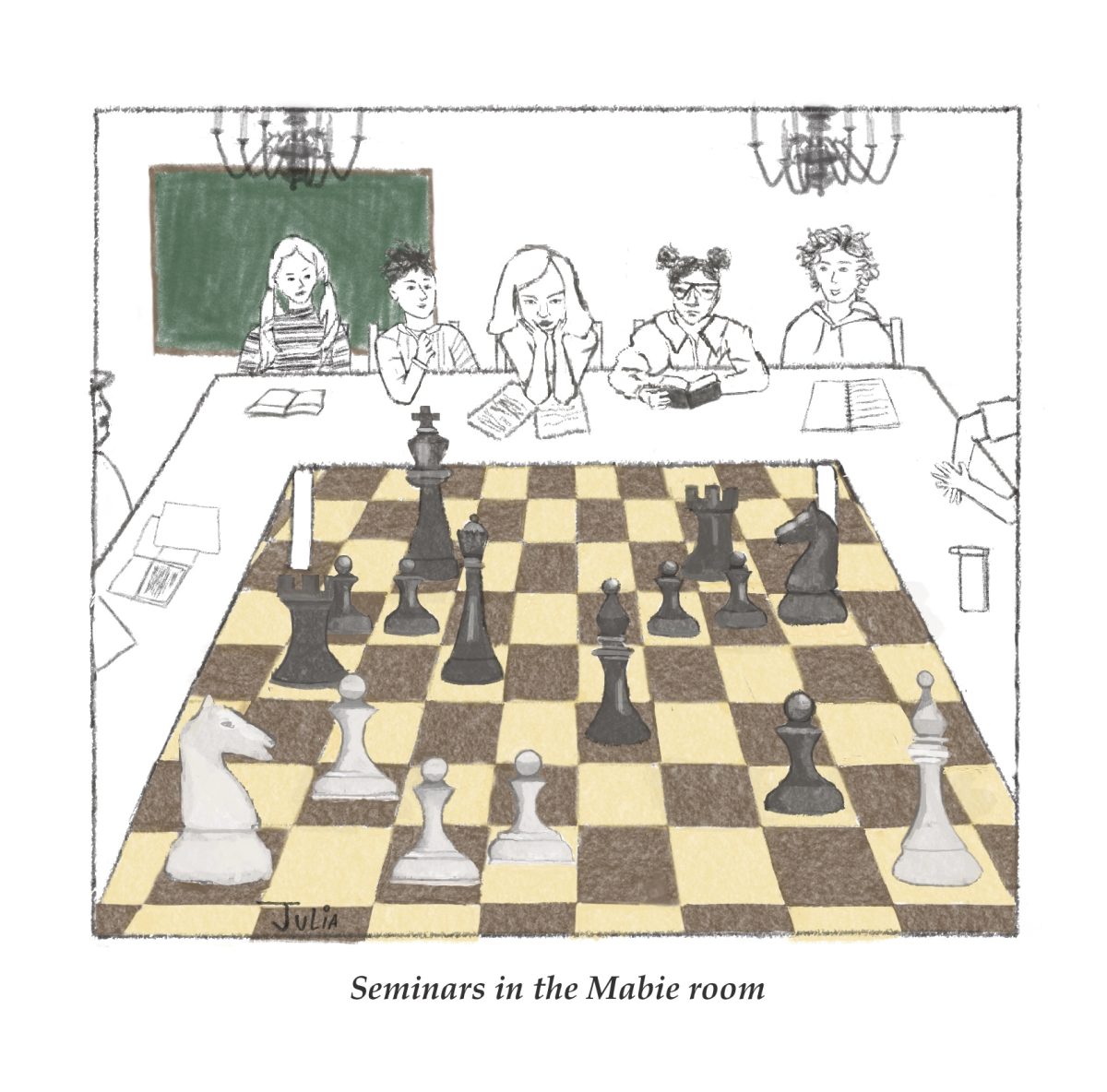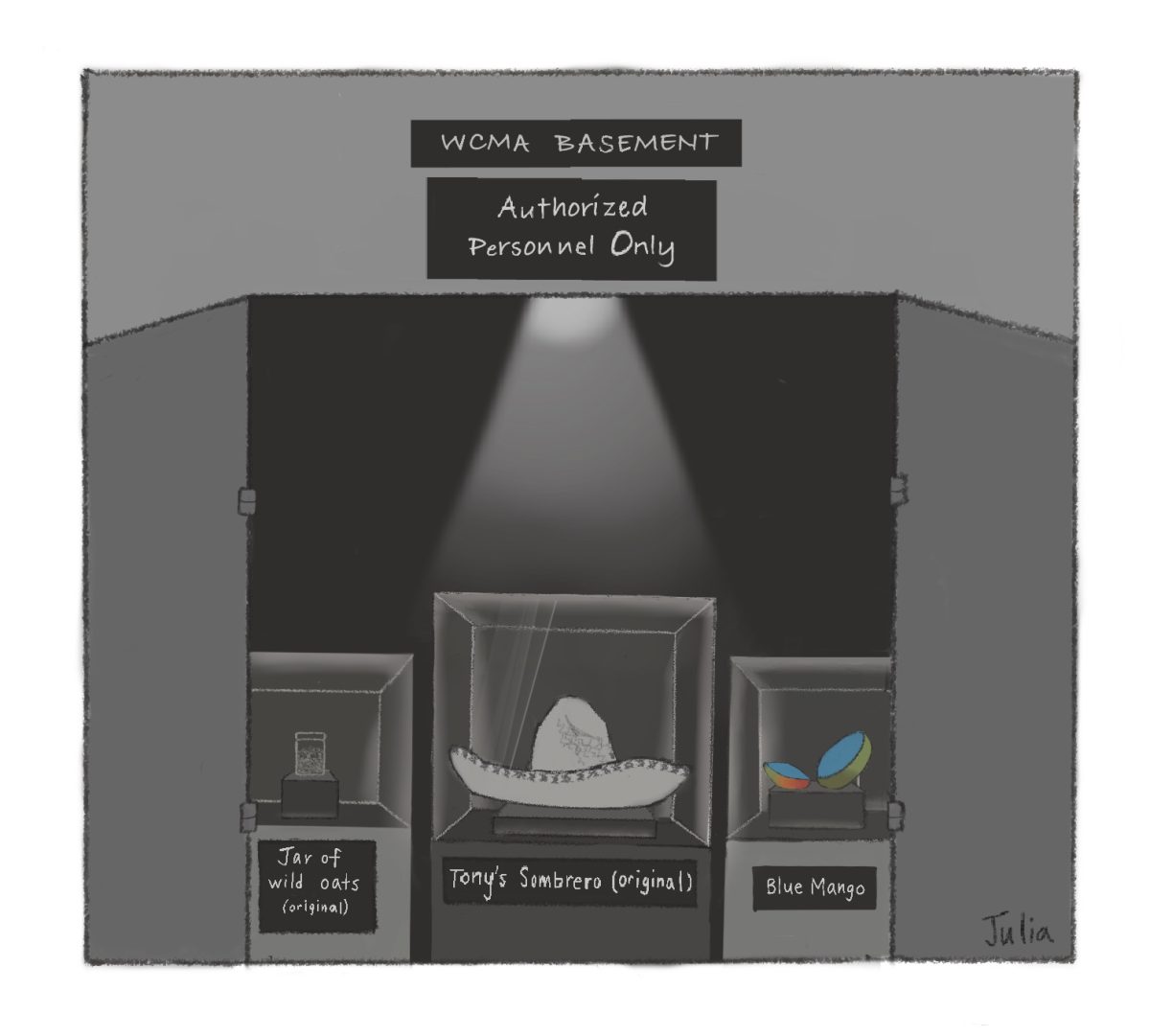‘Freed by Title IX’: Looking into the creation of the first women’s athletic teams at the College
March 9, 2022
The first women’s intercollegiate event at the College was a basketball game against Vassar, according to a March 1971 Record article. Coached by Peggy Sloane, the men’s tennis and squash coach’s wife (who decided to participate in the game’s final minutes and scored the College’s seventh basket), the team included two female students, three students’ wives, and one high school student.
The game resulted in a loss of 50-16. However, the Record wrote that this was a “building year” in women’s athletics at the College, noting that with increased participation anticipated in the coming years, “women’s teams in many sports promise to be a source of pride for Williams and community.”
An all-male institution from its founding in 1793, the College opened its doors to female exchange students in the spring of 1969. Women enrolled as full undergraduates in the fall of 1970, with the first class of female first-year students matriculating in the fall of 1971.
Coinciding with the College’s move towards coeduaction, Title IX, which prohibits discrimination on the basis of sex in educational programs including athletics, was passed in June 1972. The first official female varsity sports teams at the College were established in the fall of 1972 — and in some cases, student athletes initiated the creation of teams themselves.
‘One part of a much bigger experience’: Establishing female athletics from the ground up
Women’s varsity sports teams did not yet exist at the College when Beth Lee ’75 arrived as a first-year student in 1971. She would go on to play field hockey and squash. “I remember enlisting girls that had never played [field hockey] before just to get enough critical mass so we could actually practice and play a little bit,” Lee said. “They gave us a coach who was the [men’s] tennis coach’s wife [Peggy Sloane]… She didn’t have much experience.”
During this first year, 27 women joined the field hockey team under the direction of Coach Peggy Sloane, practicing three times a week on Cole Field, according to an Oct. 1971 Record article. The team officially began competing in the fall of 1972 and boasted a winning record of 4–1.
“Practices certainly weren’t arduous, but we definitely trained,” Liza Waters ’78, senior co-captain of the 1977 field hockey team as well as a member of the ice hockey team, said.
Cam Lanphier ’78, Waters’s field hockey co-captain, noted that the College supplied uniforms, transportation to games, and simple locker rooms at Cole Field. Also a member of the squash, ice hockey, and lacrosse teams, Lanphier said that the College put particular effort into establishing field hockey and lacrosse, which, along with basketball, were the first women’s varsity teams to be created.
Having attended an all girls high school that mandated athletic participation, Jessie Potter Kingston ’75, who played lacrosse, said she felt “naive” when she came to the College. “I just assumed there’d be sports for us,” Kingston said. “It just never occurred to me that I wouldn’t have [sports] at Williams — I didn’t even ask about it.”
During her first year, Kingston spoke to then-Director of Athletics Robert Peck and asked about the possibility of a lacrosse team. “He, in a very fair way, said that if you can demonstrate that there’s enough interest by teaching a P.E. class your freshman year, we’ll have your coach by next year,” she said. Working with Martha Tucker ’75, Kingston did just that.
“A ton of people showed up — some who had played before, some of them hadn’t and picked it up,” Kingston said of the women’s lacrosse P.E. class. “And [Robert] Peck was true to his word. The next year, we did have a coach.” Kingston was named a co-captain with Tucker, and the team had a 3–2 record its inaugural season under Coach Janis Wertz, beating Mount Holyoke, Trinity, and Dartmouth.
Similarly, before the creation of the women’s squash team, Martha C. Yergeau ’77 said she would often go down to the squash courts at the College to play for fun. “There were a number of us women who said, ‘Hey, the guys have a squash team. Why can’t we have a squash team?’” Yergeau said.
As Kingston did with lacrosse, Yergeau and others then approached Peck and the athletic department, who soon provided funding, a schedule, and a coach — Ned Reade ’75, a fellow student who played squash for three years and soccer at the College.
Reade said that Sean Sloane, the men’s tennis and squash coach, reached out to him about the possibility of coaching. “[Sloane] said, ‘Ned, I don’t have time, but I think you would be great to coach the women,’” Reade said. “He also might have given me an easy way out of not having to cut me for varsity… I think they paid me 500 bucks or something for the season.”
“It was not exactly a professionally run operation,” Lee said, adding that Clarence Chaffee, who coached men’s squash, tennis, and soccer at the College and retired two years before the formation of women’s teams, would sometimes help out with women’s squash.
Reade remembers playing against other teams, many of which had female coaches with illustrious athletic careers. “[The other coaches were] national champions in their own right, and I had nothing in common with them,” he said. “They saw Williams as a brand new team, and they probably didn’t think we were going to be very good.” However, the women’s squash team surged to an undefeated 8–0 record in its inaugural season in 1974- 75, beginning with a 7-2 victory over Yale and ending the year with a 6-3 win over Trinity. Yergeau, the College’s number one seeded player, was ranked as one of the top ten intercollegiate women in the United States.
Out of those on the inaugural roster, only Yergeau had played squash in high school. Similarly, very few women had played ice hockey before taking it up at the College, Waters said.
“Ice hockey was a thing that barely existed,” she said. “My freshman year, the only way we could play hockey was to join some P.E. hockey skills thing, so we did that. And then, we eventually cajoled [men’s hockey] Coach [Bill] McCormick to give us some ice time.”
“He listened to me,” Waters continued. “He could have sent me right out of the office and said, ‘Yeah, you’re full of crap’ … but he listened to me, and he made it work.”
“I was one of the folks who was going, ‘Gee, this would be fun,’” Sue Stred ’78 said, add- ing that she placed flyers in mailboxes and around dormitory lobbies to spread the word about the newly formed team.
Around half of the women who showed up for practice in the fall of 1976 did not know how to skate, or had little experience with hockey skates, according to Waters. “We all had to scrounge up our own equipment,” she said. “I think we just skated in sweatpants.” Stred said that the College did provide helmets, and game jerseys came from the men’s junior varsity squad — but not without confusion, as the team ended up with multiple jerseys with the numbers 8 and 9. Regardless, the team won its first game against Union 12-0 in Jan. 1977.
“I loved it,” Lanphier said. “It was a big part of my Williams experience — athletics and competing — but it was only one part of a much bigger experience.”
‘The most disciplined athletes I had encountered’: Practices, games, and new experiences
By 1975, three years after its first season, field hockey was one of the most popular female sports on campus. 60 women showed up to the first practice that fall, forcing Coaches Linda Wilkins and Bonnie Craw- ford to cut “almost as many as [they] kept” for “the first time on such a scale,” according to a Sept. 1975 Record article.
On the other hand, women’s soccer was one of the later sports to be established. After graduating from Middlebury in 1977 as a member of the field hockey, skiing, and lacrosse teams, Coach Leslie Orton ar- rived at Williams to lead the varsity women’s soccer team in its first year on the varsity level. “I came without a whole lot of soccer knowledge,” Orton said. “I was hired as the varsity [women’s] soccer coach, the head women’s ski coach, and then [women’s] JV lacrosse. Back in the day, women did everything.”
When Orton arrived, the men’s soccer team were given practice gear, while the women wore their own clothing; the men also had a practice field and a game field, while the women were only given one field. “We didn’t have the same set up as the men,” Orton said, adding that practices consisted of “footwork and really basic stuff.”
The son of a squash coach at Deerfield Academy, Reade grew up watching his father coach and incorporated his father’s drills to introduce newcomers to the game. “I can remember teaching girls how to do a drill like a forehand or backhand, and I would go from one court to the next, setting them up, [saying], ‘Okay, now do this, and I’ll be right back,’” Reade said. “And if I would for- get to get back to a court after 20 minutes, the group was still doing the same drill being re- ally dedicated and just working on it.”
“These girls were the most disciplined athletes I had encountered,” he said. “I played men’s sports, but I just hadn’t seen this kind of focus. The women — that’s the way they were.”
Orton agreed, noting that the athletes worked hard and were excited about the prospect of competing. “I think the atmosphere was like any team: You’re gung ho and you want to play,” she said.
Linda Collins ’80, a found- ing member and captain of the women’s club rugby team, said, “[Rugby] just dominated my life at Williams.”
“You didn’t have to be super athletic. You didn’t have to be really strong,” she said. “I mean, anybody could play on our rugby team. So there wasn’t the competition of having to meet a certain standard in order to be able to participate. It was all-inclusive.”
Lucienne Sanchez ’79, who played volleyball, soccer, and basketball in addition to running track, emphasized the opportunity for women to walk onto athletic teams at the College. “I had never played volleyball, never played basketball on a team, and we just went out for the tryouts at the track team,” she said. “So every season, I played something, and everything was a first for me.”
‘A memorable experience’: Seasons with adventures
Like Sanchez, Lisa Capaldini ’78, a member of the field hockey, cross country, crew, and basketball teams, said that the basketball team simply consisted of women who, before college, had mainly “played basketball in high school or played with our brothers in the driveway.”
Regardless, the basketball team was undefeated during Capaldini’s first year in 1974, boasting a 12–0 record with a season full of surprises.
“We went to Boston to play MIT, and I had this totally stupid preconception that the women on the MIT basketball team would be wearing spectacles and plastic pocket liners, carrying around slide rules, you know, the total geeks,” Capaldini said. “I was guarding this woman who was much stronger and faster than me, so you do this thing where you get between the player you’re guarding and the ref and grab the back of their shirt so they can’t run away. And I did. She turned around and said, ‘Girl, you do that again, and we have a meeting in the alley after the game.’ A memorable experience.”
Yergeau emphasized how every game produced a new experience. “Each of the schools would reflect their own school personalities,” she said. “I remember we went to Vassar [for squash], and they served tea and cookies — you know, it was a Seven Sister school. Each time we went to a place, it was a new adventure. It was fun, as long as the cars didn’t break down on the way there, which happened a few times.”
The skill level between various teams also differed. Capaldini ran the mile and the half mile in high school, and joined the College’s cross country team. “At my first race, I’d never run three miles before, so I saw everybody take off, and I tried to keep up with the fast people, which I wasn’t good enough to do,” she said. “By a mile, I was absolutely spent … so I didn’t make that mistake again. I had to learn to pace myself.”
When the College hosted Bowdoin at a later meet, Capaldini watched as a “non-athletic looking person just took off,” she said. “I said, ‘Oh, she’s doing what I did my first race. She’s really going to eat it.’ But it turned out, at the end of the race, when I crossed the finish line, she was already [finished], chatting, and it turned out to be Joan Benoit.” After attending Bowdoin for two years, Benoit won the gold medal at the first women’s marathon for the 1984 Summer Olympic Games.
The difference in skill levels between ice hockey teams was “enormous,” Stred said. “Sometimes, we were the better team. Sometimes, we were like, ‘Oh, God, we’re going to be creamed,’” she noted. “In one game, I did a stick check, so I lifted up the stick of the defender so she couldn’t put her stick on the puck, and she looked at me and said, ‘You can’t do that!’ ‘Of course I can,’ I’m thinking to myself. ‘It’s my major skill.’”
Even within the College, the level of experience and skill of female athletes fluctuated; but by the late 1970s, teams be- came stronger as younger players joined.
Robin Ellett ’77, who played basketball and lacrosse, said, “My first year [of basketball], we lost a lot. My second year, we lost a lot. My third year, we got a group of young people who really had the benefit of Title IX, who played five-women basketball their entire careers, and the benefit of what Title IX gave to women athletes was manifested in them.”
Ellett described being on the basketball team as “the best thing in the world.”
“Having been a child of Title IX, freed by Title IX… I was a good athlete, but Williams gave me the opportunity to play and to be on the forefront,” she said.
Izzy Polanco contributed reporting.
This article is the first in a two-part series about the first women’s sports teams at the College. Next week’s article will focus on team culture, camaraderie, and institutional support.









